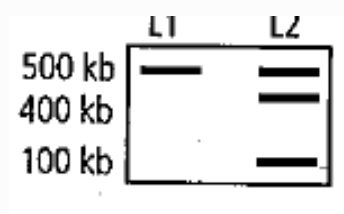Process used for amplification or multiplication of DNA in DNA fingerprinting is
1) polymerase chain reaction
2) southern blotting
3) northern blotting
4) None of these
1) polymerase chain reaction
2) southern blotting
3) northern blotting
4) None of these
The correct Answer is:A
Step by step video, text & image solution for Process used for amplification or multiplication of DNA in DNA fingerprinting is 1) polymerase chain reaction 2) southern blotting 3) northern blotting 4) None of these by Biology experts to help you in doubts & scoring excellent marks in Class 12 exams.
Updated on:21/07/2023Topper's Solved these Questions
- BIOTECHNOLOGY - PRINCIPLES AND PROCESSESBook:NCERT FINGERTPS ENGLISHChapter:BIOTECHNOLOGY - PRINCIPLES AND PROCESSESExercise:HOTS
Explore 5 Videos
- BIOTECHNOLOGY - PRINCIPLES AND PROCESSESBook:NCERT FINGERTPS ENGLISHChapter:BIOTECHNOLOGY - PRINCIPLES AND PROCESSESExercise:NCERT
Explore 19 Videos
- BIODIVERSITY & CONSERVATIONBook:NCERT FINGERTPS ENGLISHChapter:BIODIVERSITY & CONSERVATIONExercise:Biodiversity & Conservation
Explore 140 Videos
- BIOTECHNOLOGY AND ITS APPLICATIONBook:NCERT FINGERTPS ENGLISHChapter:BIOTECHNOLOGY AND ITS APPLICATIONExercise:Biotechnology And Its Application
Explore 137 Videos
Similar Questions
Knowledge Check
The figure shows the restriction enzyme cutting sites (R1−R3) in wild type (n) and mutant (n) gene.

If a radioactively labelled probe (that hybridises at a sequence close to R1) is used for detecting the presence of DNA fragments after gel electrophoresis and Southern blotting, which of the following band patterns will yout expect ?
Note : L1 : wild type DNA, L2: mutant DNAA(a) B(b)
B(b) C(c)
C(c) D(d)
D(d)
The polymerase chain reaction is a technique used for
1) amplification of DNA
2) amplification of enzymes
3) amplification of proteins
4) all of theseA1) amplification of DNAB2) amplification of enzymesC3) amplification of proteinsD4) all of theseIn the process of insertional inactivation
1) a recombinant DNA is inserted within the coding sequence of enzyme β -galactosidase, resulting in inactivation of the enzyme
2) a recombinant DNA is inserted within the coding sequence of proteins involved in the replication of the plasmid
3) a recombinat DNA is inserted within the recongnition site for EcoRl
4) none of theseA1) a recombinant DNA is inserted within the coding sequence of enzyme β-galactosidase, resulting in inactivation of the enzymeB2) a recombinant DNA is inserted within the coding sequence of proteins involved in the replication of the plasmidC3) a recombinat DNA is inserted within the recongnition site for EcoRlD4) none of these
How is the amplification of a gene (sample of interest) carried out using Polymerase Chain Reaction (PCR)
View SolutionTaq-polymerase which is used for amplification of DNA related with
View SolutionThe last step of DNA fingerprinting is
(a) Blotting
(b) Autoradiography
(c) Hybridisation
(d) Isolation of desired DNA
View SolutionMention the correct sequence of steps followed after separation of DNA fragments by electrophoresis in DNA fingerprinting.
(a) Hybridization.
(b) Autoradiography .
(c) Blotting.
View SolutionHow many of the following is/are correct statement?
(A)In capping an unusual nucleotides is added to the 3' end of hn RNA
(B)In tailing adenylated residues are added at 3' end in a template independent manner.
(C)The untranslated regions (UTR) are required for efficient DNA replication process.
(D)The DNA-dependent DNA polymerases catalyse polymerisation only in one direction that is 5' → 3'.
View Solution

